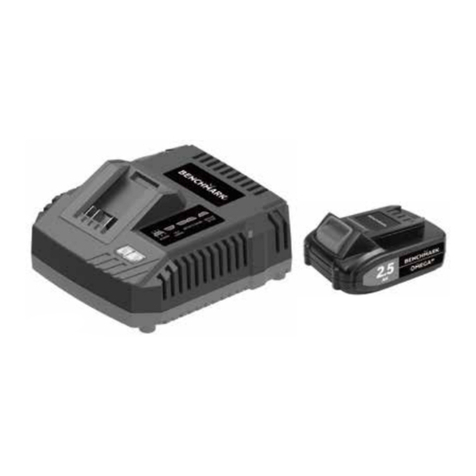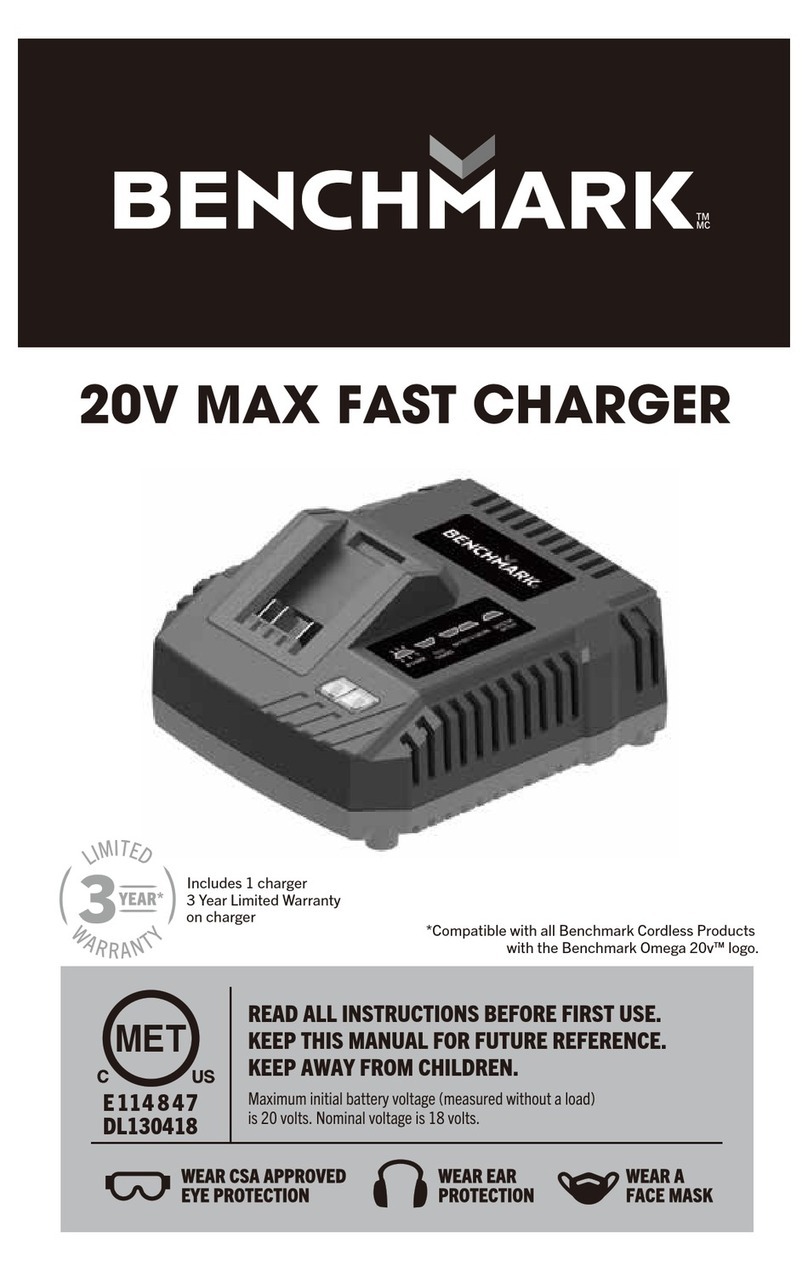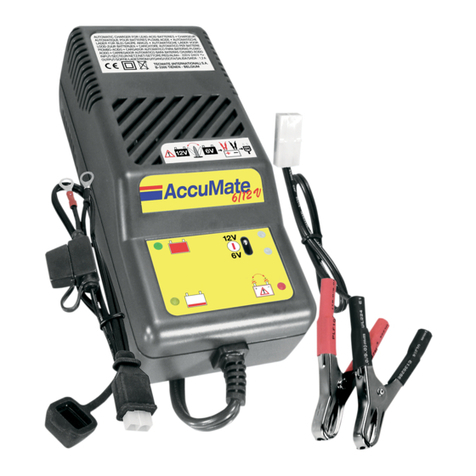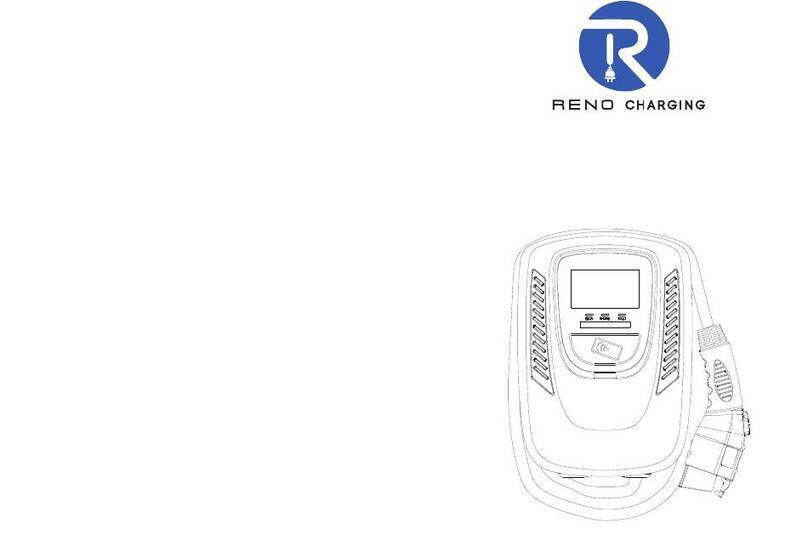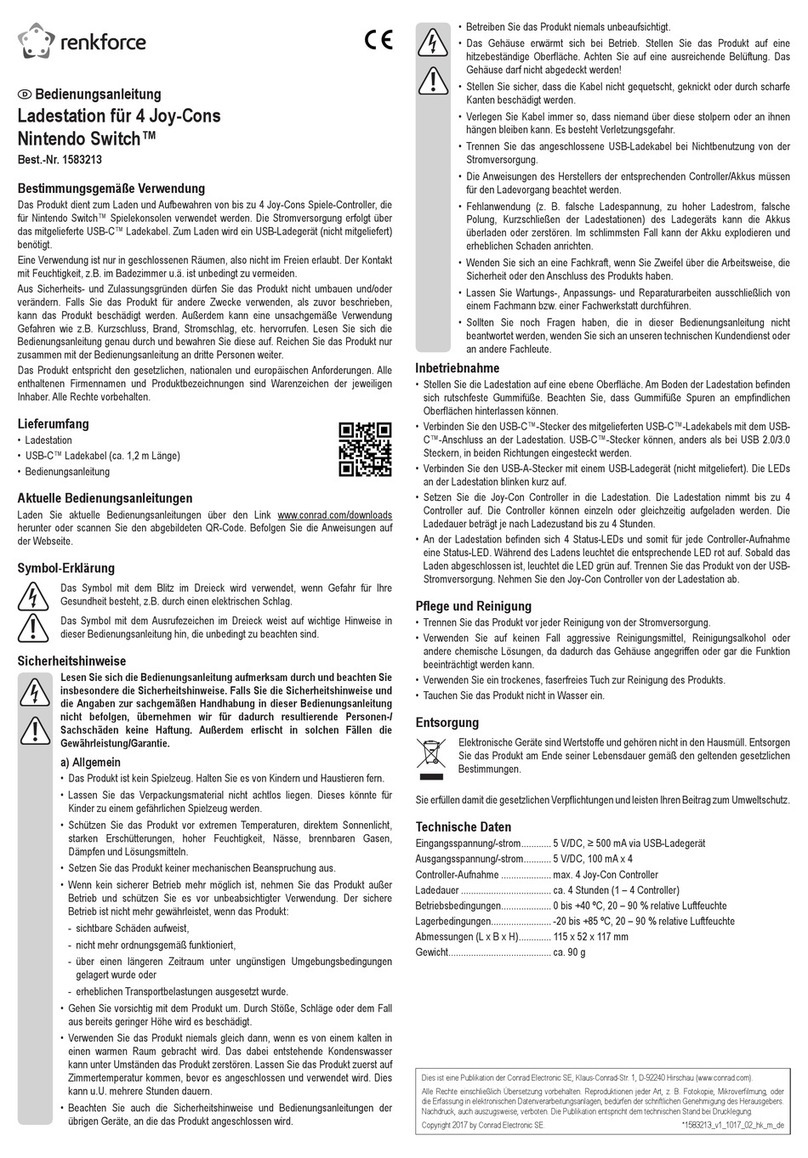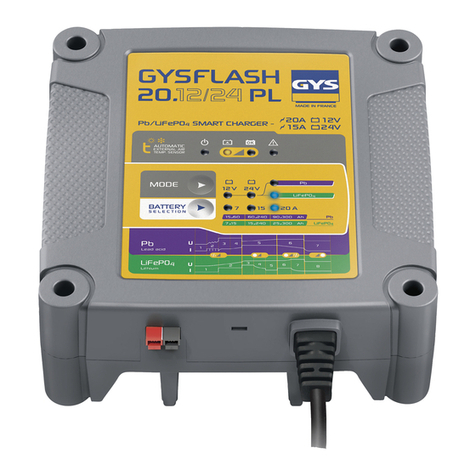Benchmark 5350-048 User manual

READ ALL INSTRUCTIONS BEFORE FIRST USE.
KEEP THIS MANUAL FOR FUTURE REFERENCE.
KEEP AWAY FROM CHILDREN.
20V MAX 4 AMP
DUAL FAST CHARGER
*Compatible with all Benchmark Cordless Products
with the Benchmark Omega 20v™ logo.
Includes 1 charger
3 Year Limited Warranty
on charger
MET
E 114 8 47
DL135418
Item # 5350-048

1
PRODUCT SPECIFICATIONS
20V MAX 4A DUAL FAST CHARGER
Voltage 120V~, 60Hz, 190W
Output Voltage 21V ~, 4Ax2
Accommodates the following batteries (sold separately)
5350-023 (2.5Ah) Charge time – up to 46 Minutes
5350-011 (4Ah) Charge time – up to 67 Minutes
5350-012 (5Ah)
5350-049 (8Ah)
Charge time – up to 83 Minutes
Charge time – up to 133 Minutes
Weight 3.48lbs (1.58kg)
NEED ASSISTANCE?
Call us on our toll-free customer support line:
1-866-349-8665
(Monday through Friday 9am – 5pm Eastern Standard Time)
• Technical questions
• Replacement parts
• Parts missing from package.

5350-048
20V MAX 4A DUAL FAST CHARGER
2
TABLE OF CONTENTS
Product Specifications................................................................................... 1
Table of Contents ........................................................................................... 2
General Safety Warnings .......................................................................... 3-7
Symbols......................................................................................................... 7
Know your Dual Fast Charger ........................................................................ 8
Operation .................................................................................................. 9
9
Warranty ......................................................................................................

GENERAL SAFETY WARNINGS
WARNING
Read all safety warnings and all instructions. Failure to follow the warnings and
instructions may result in electric shock, fire and/or serious injury. Save all warnings
and instructions for future reference. The term “power tool” in the warnings refers to
your mains-operated (corded) power tool or battery-operated (cordless) power tool.
3
SAFETY SYMBOLS
SYMBOL MEANING
ALWAYS WEAR EYE PROTECTION THAT CONFORMS WITH CSA Z94.3 or
ANSI SAFETY STANDARD Z87.1
FLYING DEBRIS can cause permanent eye damage.
Prescription eyeglasses ARE NOT a replacement for proper eye protection.
The usage of a safety standard compliant face shield placed over proper
safety glasses or goggles can reduce the risk of facial injury.
Non-compliant eyewear can cause serious injury if broken during the
operation of a power tool.
Use hearing protection, particularly during extended periods of operation
of the tool, or if the operation is noisy.
WEAR A DUST MASK THAT IS DESIGNED TO BE
USED WHEN OPERATING A POWER TOOL IN A
DUSTY ENVIRONMENT.
Dust that is created by power sanding, sawing, grinding, drilling, and other
construction activities may contain chemicals that are known to cause
cancer, birth defects,
or other genetic abnormalities. These chemicals include:
• Lead from lead-based paints
• Crystalline silica from bricks, cement, and other
masonry products
• Arsenic and chromium from chemically treated lumber
The level of risk from exposure to these chemicals varies, according to how
often this type of work is performed. In order to reduce exposure to these
chemicals, work in a
well-ventilated area, and use approved safety equipment, such as a dust mask
that is specifically designed to filter
out microscopic particles.
TO AVOID ELECTRICAL HAZARDS,
FIRE HAZARDS OR DAMAGE TO THE TOOL,
USE PROPER CIRCUIT PROTECTION.
This tool is wired at the factory for 120 V AC operation. It must beconnected
to a 120 V AC, 15 A circuit that is protected by a time-delayedfuse or circuit
breaker. To avoid shock or fire, replace power cordimmediately if it is worn, cut
or damaged in any way.

1) WORK AREA SAFETY
a) Keep work area clean and well lit. Cluttered or dark areas invite accidents.
b) Do not operate power tools in explosive atmospheres, such as in the presence
of flammable liquids, gases or dust. Power tools create sparks which may ignite
the dust or fumes.
c) Keep children and bystanders away while operating a power tool. Distractions
can cause you to lose control.
2) ELECTRICAL SAFETY
a) Power tool plugs must match the outlet. Never modify the plug in any way.
Do not use any adapter plugs with earthed (grounded) power tools. Unmodified
plugs and matching outlets will reduce risk of electric shock.
b) Avoid body contact with earthed or grounded surfaces, such as pipes, radiators,
ranges and refrigerators. There is an increased risk of electric shock if your body
is earthed or grounded.
c) Do not expose power tools to rain or wet conditions. Water entering a power tool
will increase the risk of electric shock.
d) Do not abuse the cord. Never use the cord for carrying, pulling or unplugging
the power tool. Keep cord away from heat, oil, sharp edges or moving parts.
Dam- aged or entangled cords increase the risk of electric shock.
e) When operating a power tool outdoors, use an extension cord suitable for
outdoor use. Use of a cord suitable for outdoor use reduces the risk of electric
shock.
f) If operating a power tool in a damp location is unavoidable, use a residual current
device (RCD) protected supply. Use of an RCD reduces the risk of electric shock.
3) PERSONAL SAFETY
a) Stay alert, watch what you are doing and use common sense when operating
a power tool. Do not use a power tool while you are tired or under the influence
of drugs, alcohol or medication. A moment of inattention while operating power
tools may result in serious personal injury.
b) Use personal protective equipment. Always wear eye protection. Protective
equipment such as dust mask, non-skid safety shoes, hard hat, or hearing
protection used for appropriate conditions will reduce personal injuries.
c)
connecting to power source and/or battery pack, picking up or carrying the tool.
Carrying power tools with your finger on the switch or energizing power tools
4
5350-048
20V MAX 4A DUAL FAST CHARGER
WARNING: Ventilation openings in batteries and chargers must always
be open to allow cooling air to circulate freely. Air vents that are blocked,
restricted or covered may result in the battery or charger overheating.
Overheating may lead to damage to the tool or cause a fire, resulting in
possible serious injury.

d) Remove any adjusting key or wrench before turning the power tool on.
A wrench or a key left attached to a rotating part of the power tool may result
in personal injury.
e) Do not overreach. Keep proper footing and balance at all times. This enables
better control of the power tool in unexpected situations.
f) Dress properly. Do not wear loose clothing or jewellery. Keep your hair, clothing
and gloves away from moving parts. Loose clothes, jewellery or long hair can be
caught in moving parts.
g) If devices are provided for the connection of dust extraction and collection
facilities, ensure these are connected and properly used. Use of dust collection
can reduce dust-related hazards.
4) POWER TOOL USE AND CARE
a Do not force the power tool. Use the correct power tool for your application.
The correct power tool will do the job better and safer at the rate for which
it was designed.
b)
tool that cannot be controlled with the switch is dangerous and must be repaired.
c) Disconnect the plug from the power source and/or the battery pack from
the power tool before making any adjustments, changing accessories, or storing
power tools. Such preventive safety measures reduce the risk of starting the
power tool accidentally.
d) Store idle power tools out of the reach of children and do not allow persons
unfamiliar with the power tool or these instructions to operate the power tool.
Power tools are dangerous in the hands of untrained users.
e) Maintain power tools. Check for misalignment or binding of moving parts,
operation. If damaged, have the power tool repaired before use. Many accidents
are caused by poorly maintained power tools.
f) Keep cutting tools sharp and clean. Properly maintained cutting tools with sharp
cutting edges are less likely to bind and are easier to control.
g) Use the power tool, accessories and tool bits etc. in accordance with these
instructions, taking into account the working conditions and the work to be
could result in a hazardous situation.
5) BATTERY TOOL USE AND CARE
a) Recharge only with the charger specified by the manufacturer. A charger that
is suitable for one type of battery pack may create a risk of fire when used with
another battery pack.
b) Use power tools only with specifically designated battery packs. Use of any
other battery packs may create a risk of injury and fire.
c) When battery pack is not in use, keep it away from other metal objects,
like paper clips, coins, keys, nails, screws or other small metal objects, that can
make a connection from one terminal to another. Shorting the battery terminals
together may cause burns or a fire.
5

d) Under abusive conditions, liquid may be ejected from the battery; avoid contact.
If contact accidentally occurs, flush with water. If liquid contacts eyes, addition-
ally seek medical help. Liquid ejected from the battery may cause irritation or
burns.
6) SERVICE
Have yourpowertool serviced by a qualified repairperson using only identical
replacement parts. This will ensure that the safety of the power tool is maintained.
BATTERY CHARGER SAFETY INSTRUCTIONS
Before using the charger read all instructions and cautionary markings
on the charger, battery pack and the product using the battery pack.
This charger is not intended for any uses other than charging the rechargeable
batteries noted. Any other use may result in risk of fire, electric shock or electrocu-
tion.
Do not place any object on top of the charger or place the charger on
a soft surface that may result in excessive internal heat. Place the charger
in a position away from any heat source.
To reduce risk of damage to the electric plug and cord, pull by the plug rather
than the cord when disconnecting the charger.
Make sure the cord is located so that it will not be stepped on, tripped over,
or otherwise subjected to damage or stress.
An extension cord should not be used unless absolutely necessary. Use of
an improper extension cord could result in the risk of fire, electric shock
or electrocution.
Do not operate the charger if it has received a sharp blow, been dropped
or otherwise damaged inany way. Have it checked by anelectrician
or power toolrepairer.
Do not disassemble charger. Take it to an electrician or power tool repairer
when service or repair is required. Incorrect reassembly may result in a risk of
electric shock, electrocution or fire.
To reduce risk of electric shock, unplug the charger from the outlet before
attempting any cleaning. Removing the battery pack will not reduce this risk.
Never attempt to connect 2 chargers together.
DO NOT store or use the tool and battery pack in locations where the
temperature may reach or exceed 40ºC (such as inside sheds or metal
buildings in summer).
The charger is designed to operate on standard household electrical power
120 volts. Do not attempt to use it on any other voltage!
The battery pack is not fully charged out of the carton. First read the safety
instructions and then follow the charging notes and procedures.
Do NOT charge the batteries when the work area or the battery temperature
is at or below 5° C (41° F) or above 40.5° C (105° F).
Unplug the charger when not in use and before cleaning or maintenance.
6
5350-048
20V MAX 4A DUAL FAST CHARGER

7
Do not incinerate the battery pack even if it is seriously damaged or is completely
worn out. The battery can explode in a fire.
Never attempt to open the battery pack for any reason. If the plastic housing
of the battery pack breaks or cracks, immediately discontinue use and do not
recharge.
During charging, the battery must be placed in a well ventilated area.
This symbol designates that this tool is listed with U.S.
requirements by MET Laboratories, Inc.
Conforms to UL 1310
Certified to CAN/CSA STD C22.2 No 223-15
This charger is double insulated. Therefore no ground is required.
SYMBOLS
The rating plate on your tool may show symbols. These represent important
information about the product or instructions on it use.
MET
E 114 8 47
DL135418
BATTERY PACK RECYCLING
To preserve our natural resources, please recycle or dispose
of batteries properly. The batteries charged by this charger
may contain chemicals and metals that are harmful to the
environment. Never dispose of rechargeable batteries in your
normal household garbage or in landfill sites as they will add to the
pollution of the environment.
Direct current, DC
Refer to instruction manual/booklet
Indoor use only
Fuse
Polarity symbol
Waster electricalproducts should not be disposed of with
household waste. Please recycle where facilitues exist.
Check with your Local Authority or retailer for recycling advice.
Double insulated for additional protection
General warning
Regular compliancemark

KNOW YOUR DUAL FAST CHARGER
CHARGING PORTS
POWER CABLE
LED CHARGING INDICATOR LIGHTS
AIR VENTS
8
5350-048
20V MAX 4A DUAL FAST CHARGER
HOW TO INSERT BATTERY ON CHARGER
1. Align battery ribs with charger ( FIG.1(a) )
2. Slowly slide into charger ( FIG.1(b) )
3. Stop when you hear the latch click ( FIG.1(c) )
TO REMOVE BATTERY:
Press & hold button on battery & follow steps in reverse.
FIG.1
FIG 1
*CLICK*
a b c

9
OPERATION
LED CHARGING INDICATOR LIGHTS
WARNING
If at any point during the charging process, none of the LED lights on the charger
are lit– remove the battery pack from the charger to avoid damaging
the product. Do not insert another battery.
The LED charging indicators lights show what charge state the battery is in:
Red – Charging
Green – Charged (or no battery installed)
THERMAL PROTECTION
When repeatedly using the charger to charge a number of batteries always allow
the charger to cool down before charging another battery. It is recommended
that the cooling down period is not less than 30 to 45 minutes.
When charging a battery that has been discharged during heavy use allow
the battery to cool down before charging. It is recommended that the cooling
down period is not less than 30 to 45 minutes.
A safety feature of this battery system is that if the Battery Pack is too hot to
be charged, the battery charger will NOT start charging and the light will remain
green. When the battery pack has cooled, the charger will start charging.
WARRANTY
If this Benchmark Tool fails due to a defect in material or workmanship within five
years from the date of purchase, return it to any Home Hardware store with the original
bill of sale for exchange. 3 years for battery and charger.
This warranty does not include expendable parts including but not limited to blades,
brushes, belts and light bulbs. This warranty covers defects in material or workmanship
only. It does not cover normal wear and tear, failure due to abuse/misuse, or defects
caused by careless or accidental mishandling.If this Benchmark product is used for
commercial or rental purposes, this warranty does not apply Need Assistance?

READ ALL INSTRUCTIONS BEFORE FIRST USE.
KEEP THIS MANUAL FOR FUTURE REFERENCE.
KEEP AWAY FROM CHILDREN.
WEAR CSA APPROVED
EYE PROTECTION
WEAR EAR
PROTECTION
WEAR A
FACE MASK
Made in China
5350-048
BENCHMARK TOOLS CANADA
ST. JACOBS, ONTARIO N0B 2N0
©2022 Home Hardware Stores Limited
TM
MC
CUSTOMER SERVICE/TECH SUPPORT
1-866-349-8665
* This BenchmarkTM product carries a three (3) year LIMITED warranty against defects
in workmanship and materials. See Owner’s Manual for full details.
*Compatible with all Benchmark Cordless Products
with the Benchmark Omega 20v™ logo.
20V MAX 4 AMP
DUAL FAST CHARGER
MET
E 114 8 47
DL135418
Item# 5350-048
Table of contents
Other Benchmark Batteries Charger manuals
Popular Batteries Charger manuals by other brands
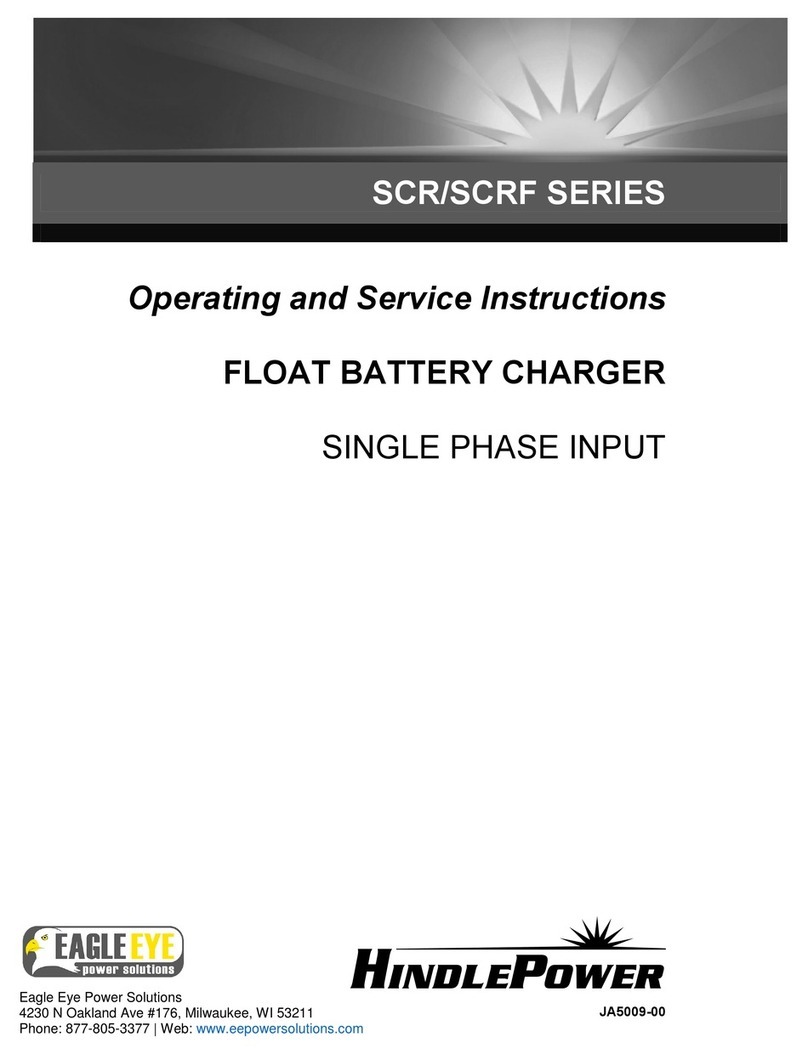
HindlePower
HindlePower SCRF series Operating and service instructions

VOLTCRAFT
VOLTCRAFT V-CHARGE 1S QUAD operating instructions

CTEK
CTEK D250SE quick start guide

newmotion
newmotion Home Advanced Edition 7 instruction manual

UNIROSS
UNIROSS COMPACT CHARGER - NOTICE 2 operating instructions

Bosch
Bosch BPC3400 Original operating instructions
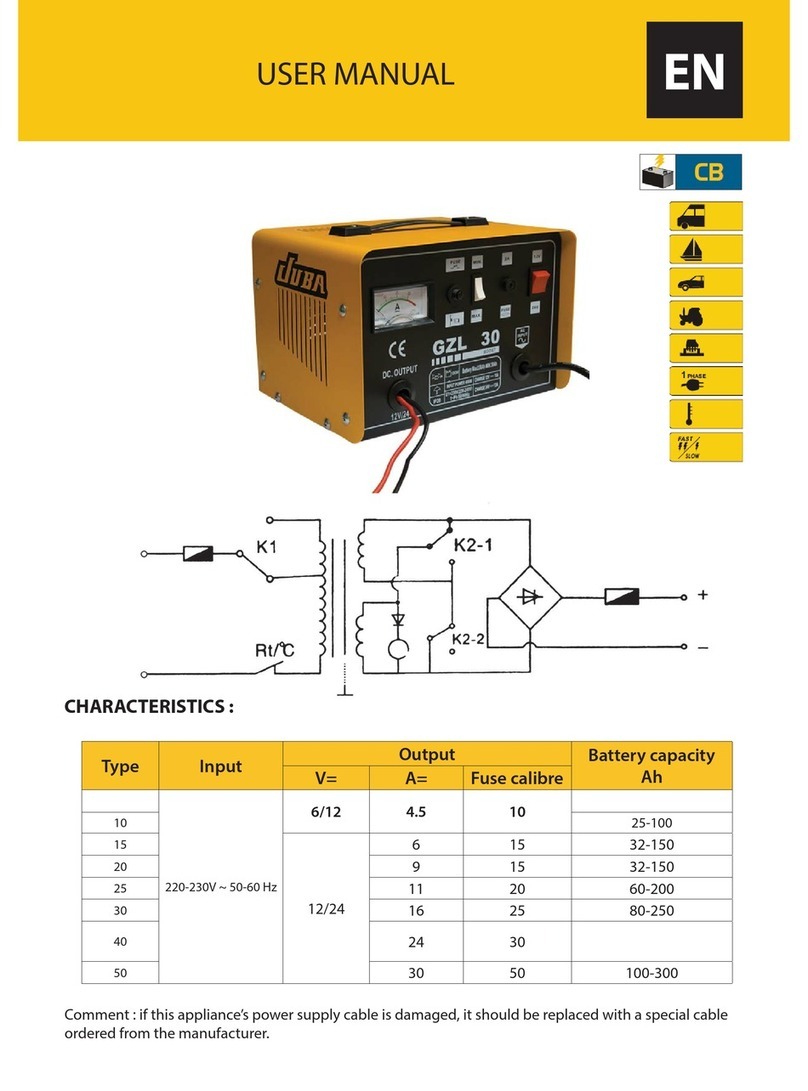
Juba
Juba GZL 15 user manual

Enatel Motive Power
Enatel Motive Power FS5 Operator and installation manual

Team Orion
Team Orion Advantage Touch Quick start manual
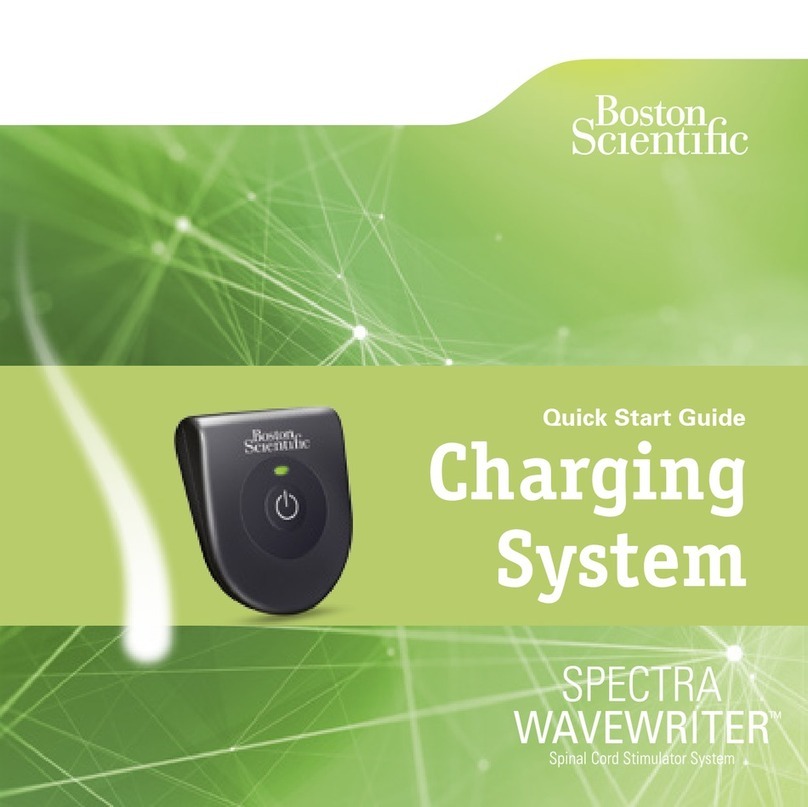
Boston Scientific
Boston Scientific SPECTRA WAVEWRITER quick start guide
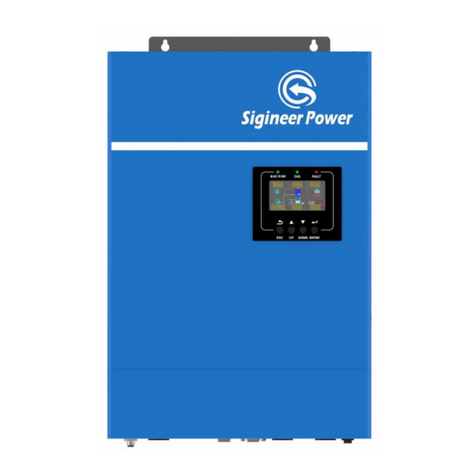
Sigineer Power
Sigineer Power M3048BP user manual

GYS
GYS GYSPack 810 instruction manual
